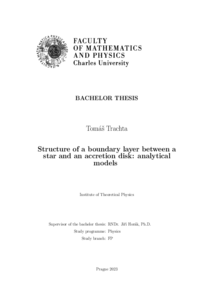Structure of a boundary layer between a star and an accretion disk: analytical models
Struktura okrajové vrstvy mezi hvězdou a akrečním diskem: analytické modely
bachelor thesis (DEFENDED)

View/
Permanent link
http://hdl.handle.net/20.500.11956/182539Identifiers
Study Information System: 257769
Collections
- Kvalifikační práce [11462]
Author
Advisor
Referee
Karas, Vladimír
Faculty / Institute
Faculty of Mathematics and Physics
Discipline
Physics
Department
Institute of Theoretical Physics
Date of defense
21. 6. 2023
Publisher
Univerzita Karlova, Matematicko-fyzikální fakultaLanguage
English
Grade
Excellent
Keywords (Czech)
hydrodynamika|akrece|poruchové metodyKeywords (English)
hydrodynamics|accretion|perturbation methodsV této práci se pokoušíme najít trojrozměrné řešení Navier-Stokesových rovnic popisu- jících α-disk akreující na neutronovou hvězdu. Řešení pro velké radiální vzdálenosti je dobře známé, nicméně vede k singularitě na poloměru, kde je silový moment nula. Na okolí tohoto poloměru se vytvoří okrajová vrstva, jelikož řešení pro velké radiální vzdálenosti nemůže splnit vnitřní okrajové podmínky, tudíž toto řešení přestává být platné. Matematicky jde o singulární perturbace. Abychom se zbavili této singular- ity, použijeme metodu napojených asymptotických rozvojů, což vede na nové pohybové rovnice. V první části práce shrnujeme známé výsledky, které nám pomohou s argumenty pro přeškálování rovnic. Ve druhé části škálujeme rovnice a pokoušíme se je vyřešit. 1
In this work, we attempt to find a three-dimensional solution to the Navier-Stokes equations describing an α-disk accreting onto a neutron star. The solution for great radial distances is well-known. However, this solution leads to a singularity at the zero-torque radius. A boundary layer arises in the neighbourhood of this radius since the solution for great radial distances cannot fulfil the inner boundary condition, therefore it stops being valid. Mathematically we are dealing with singular perturbations. In order to eliminate this singularity, we will use the method of matched asymptotic expansions, which leads to new equations of motion. First, we review known results, then we provide arguments for rescaling the equations of motion, and we attempt to solve the rescaled equations. 1
